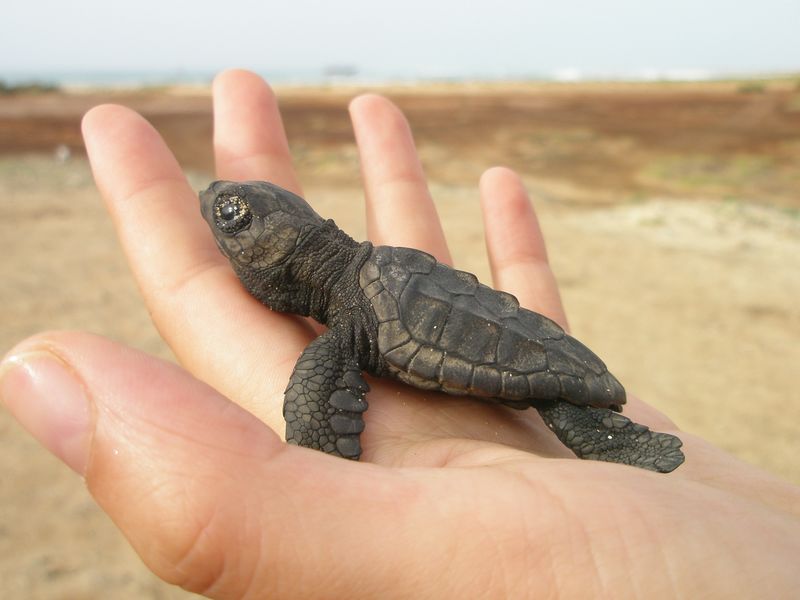Cerca de seis mil tartarugas desovaram este ano nas praias da ilha da Boa Vista
17 de Outubro de 2012, 16:50
Um número recorde de cerca de seis mil tartarugas visitaram as praias da ilha da Boa Vista para nidificarem durante o Verão, de acordo dados apresentados hoje pelas duas ONG que trabalham com as tartarugas na ilha.
 Os números foram apresentados esta manhã em comemoração ao Dia Internacional das Tartarugas Marinhas, na sede do Projecto de Consolidação do Sistema das Áreas protegidas da Boa Vista, na presença do director -geral do Ambiente, Moisés Borges, e de representantes das duas ONG, Natura 2000 e Fundação Tartaruga.
Os números foram apresentados esta manhã em comemoração ao Dia Internacional das Tartarugas Marinhas, na sede do Projecto de Consolidação do Sistema das Áreas protegidas da Boa Vista, na presença do director -geral do Ambiente, Moisés Borges, e de representantes das duas ONG, Natura 2000 e Fundação Tartaruga.
O número apresentado advém da contagem dos cerca de 30 mil ninhos divididos por cinco, segundo Ana Liria, coordenadora científica do Projecto Natura 2000, que explico que mesmo ano a fêmea nidifica cinco vezes a cada 15 dias e depois espera dois anos para voltar às praias.
De acordo com os mesmos dados, cerca de 30 tartarugas foram mortas para consumo/venda da carne, nas praias onde trabalham.
As duas organizações apresentaram queixaram-se unto ao Director Geral do Ambiente das dificuldades na sensibilização da comunidade civil, embora reconheçam que o número de abates esteja a diminuir a cada ano.
O Projecto Natura 2000 cobre uma área de 20 quilómetros e a Fundação Tartaruga está encarregue pela protecção de 25 km de praia. (o texto original apresenta erro de digitaçao na extensao de praia protegida pela TF - o correto é 25 km, e nao 225).
O número de tartarugas que visita a ilha vinha, segundo a Natura 2000, aumentando desde 1998 até 2009, tendo este número sofrido uma “grande queda” nos dois anos seguintes.
Ana Liria explicou que o ciclo de vida das tartarugas é muito complexo, mas a temperatura das correntes está directamente ligada com a reprodução, ou seja, assinalou, “se apanham águas frias alimentam-se mal, a digestão é lenta e não produzem a energia necessário para produzir os ovos”.
A ilha da Boa Vista tem a terceira população mais importante do mundo e a única nidificante na costa Este do Atlântico, abriga cerca de 70 por dos ninhos do país. A frente da Boa Vista estão a Costa Este, dos EUA, e Omã, na Península Arábica.
Segundo Liria, o numero 80 é especial para as tartarugas: colocam cerca de 80 ovos de cada vez; vivem mais ou menos 80 anos e pesam aproximadamente 80 quilos.
Explicou ainda que a cada mil tartarugas que nascem, só uma chega à idade adulta, ainda sublinhou, “é muito importante fazer estudos a largo prazo”.
Os machos chegam a Cabo Verde em Maio e as fêmeas em Junho, as tartarugas começam a nascer em finais de Agosto e pode estender –se até finais de Novembro, mas, a maior parte nasce durante o mês de Setembro, sendo que a eclosão dá-se em dois meses.
@Inforpress/Fim


 Os números foram apresentados esta manhã em comemoração ao Dia Internacional das Tartarugas Marinhas, na sede do Projecto de Consolidação do Sistema das Áreas protegidas da Boa Vista, na presença do director -geral do Ambiente, Moisés Borges, e de representantes das duas ONG, Natura 2000 e Fundação Tartaruga.
Os números foram apresentados esta manhã em comemoração ao Dia Internacional das Tartarugas Marinhas, na sede do Projecto de Consolidação do Sistema das Áreas protegidas da Boa Vista, na presença do director -geral do Ambiente, Moisés Borges, e de representantes das duas ONG, Natura 2000 e Fundação Tartaruga.